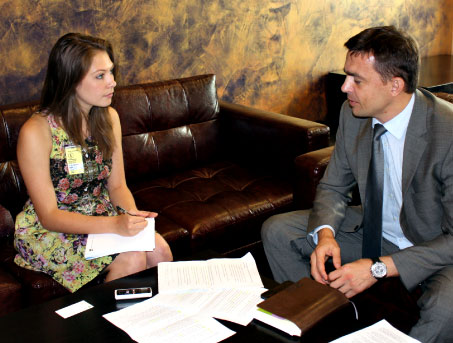
Kochanov: “I see a lot of unrealised potential that I will try to make the best use of. The last few years have seen the ongoing construction of a number of new terminals here – in Lviv, Donetsk, Odessa and Kharkiv, as well as Boryspil – and we now have all the infrastructure to speed up the development of aviation in Ukraine.”
The Ukrainian aviation industry is transforming. Exponential development is taking place at airports across the country, where popularity with tourists has prospered since it hosted the EURO 2012 tournament, and continues to flourish as visitors are seduced by the cornucopia of mountains, beaches and spas just a short distance from its cosmopolitan capital. The expansion of the industry is key to the country’s continuing growth and independence, and though obstacles still stand in the way of fully liberalised operations, its airports and airlines are on a mission to increase competition, educate passengers and amend the regulatory stumbling blocks that are curbing their expansion worldwide.
Its airports aren’t just catching up with the standards set by rest of the world, but are also implementing industry-leading innovations and ingenuity, with the modern new Terminal D at Kyiv Boryspil International Airport serving as a shining glass and steel symbol of the potential of the nation’s hubs. The state-owned airport currently handles around 60% of the nation’s air traffic, and with its updated infrastructure providing a state-of-the-art platform for its continually escalating passenger numbers, airlines are champing at the bit to establish bases at Boryspil.
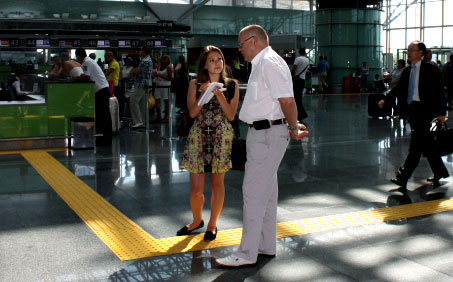
It is hoped that by the end of this year the European Union will come to an agreement with the aviation authorities of Ukraine in the signing of the Open Skies Agreement, which will give renewed impetus to the nation’s entire aviation industry.
“I think Ukrainian civil aviation has great prospects,” Kochanov explained. “Boryspil Airport has huge potential because it has so much available capacity within the newly created infrastructure.” The new Terminal D is close to twice the size of the 60,000sqm airport that preceded it, boasting abundant space and the industry’s most innovative features for the airport’s 8.5 million yearly passengers. “I have spent all my life working in aviation, and now I see a lot of unrealised potential that I will try to make the best use of, working together with the Ministry of Infrastructure and the government. The last few years have seen the ongoing construction of a number of new terminals here – in Kiev, Lviv, Donetsk, Odessa and Kharkiv, as well as Boryspil – and we now have all the infrastructure to speed up the development of aviation in Ukraine.”
Kiev’s game-changing new terminal
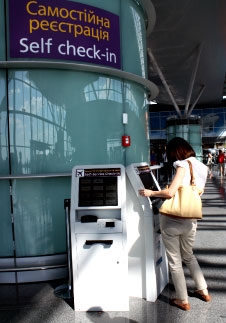
Boryspil’s new 107,000sqm terminal boasts 60 check-in desks and six self-service desks, automated e-Gates and a state-of-the-art Vanderlande baggage handling system, as well as 11 passenger boarding bridges. It is capable of handling 3,000 inbound and 3,000 outbound passengers every hour.
2012 was a milestone year for Boryspil International Airport; the unveiling of its sophisticated new Terminal D opened myriad new and auspicious opportunities for the hub. “Terminal D is one of the most state-of-the-art terminals in Europe,” Kochanov said. “We have implemented the most modern of systems, such as the climate control systems, check-in and customs technologies, and safety systems.”
The 107,000sqm terminal complex is the largest in Ukraine, and is capable of handling more than 15 million passengers a year. It has 60 check-in desks and spacious concourse areas, while 11 new boarding bridges have maximised the potential of the airport’s unique dual runway infrastructure, and been developed with long-term expansion in mind. The bridges are equipped with an automatic aircraft docking system to decrease docking time, and a visual guidance system is also in place to enhance efficiency in poor weather.
The passenger was at the heart of the new terminal’s development, one aspect of which is the implementation of an automated e-Gate system with RFID technology, which enables passengers to pass through customs in 20-30 seconds, reducing the time taken for immigration processes by -80%. “Working together with the customs and border services of Ukraine we are developing a working schedule which has taken into account the peak times of operation in the airport,” added Kochanov. “Together with several of our airlines we have worked out preliminary registration schemes which allow passengers to register via the internet without entering the airport. Today we are going to great lengths to reduce the time passengers spend in the check-in zone or waiting for registration so that they can spend more time in the airport’s restaurants and cafés.”
The airport has also installed multi-use self check-in kiosks for passengers travelling with KLM, British Airways, Air France, Lufthansa, Austrian Airlines, Rossiya Airlines and Turkish Airlines, with another three airlines set to join the system before the end of the year. “We have free WiFi access too,” Kochanov said. “The system is extremely popular, and we have about three million connections every year. We are trying to be as modern as we can, to think ahead of time and put a lot of effort into educating our staff so that we are not lagging behind the current state of aviation.”
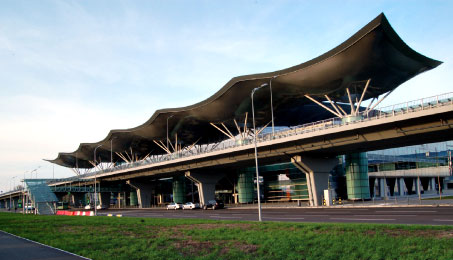
Boryspil’s improved infrastructure and state-of-the-art facilities have captured the attention of a number of international airlines. Beginning on 27 November, SWISS Air will resume a regular service from Zürich to Boryspil, while starting from 14 January, Emirates will provide daily flights from Dubai to the Kiev hub.
Opened in May 2012, weeks before the EURO 2012 tournament in Kiev, the terminal’s first great trial was ensuring the safety and swift processing of hundreds of thousands of tourists, and the tournament also brought with it a more competitive industry environment, with the opening of Kiev’s newly redeveloped second airport, International Airport Kyiv. Despite competition, Boryspil’s passenger traffic continues to multiply, and with its new infrastructure almost complete, its emphasis is now on developing connections with more and more airlines, and realising further growth.
Continuing growth
In his previous role as CEO of the nearby Odessa International Airport, Kochanov attracted more than 15 international airlines to the airport, elevated its throughput to become the third highest in the country, and initiated the terminal development which is currently underway. After just weeks as Director General at Boryspil Airport, he has applied his enterprise and drive to operations at the Kiev hub.
Kochanov said: “Before I came to Boryspil a lot of beneficial projects had already been accomplished, and the airport had been greatly developed. However, the efforts of the previous administration concentrated on the construction of the new terminal ahead of EURO 2012, and there was no finalised picture created of how the airport should function upon the completion of the Terminal D. As a result, Boryspil has received a state-of-the-art new complex that is in no way related to and can in no way cooperate with the other existing terminals.”
Kochanov’s goal is now to create a connection between the new and existing terminals. “In the first three weeks of our work my team and I have managed to create an improvement programme and have it approved by the Ministry of Infrastructure and the airport’s major carriers. According to the scheme, all internal Ukraine flights will be transferred from Terminal B to Terminal D. We have also created transfer capacities for those passengers transferring from Ukrainian flights to international and vice versa.” Terminal B, meanwhile, will be transformed into a specialist terminal for low-cost carriers and chartered flights, while Terminal F will be transformed into a cargo terminal.
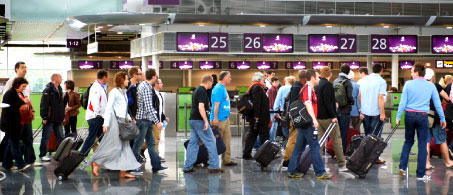
Kochanov: “As with any other airport, Boryspil’s ultimate goal is to serve more and more passengers. Our main aim is to increase throughput by +15% compared to the current numbers. We’re expecting eight million passengers to use the airport by the end of 2013, and in the following year we expect a few more than nine million, with a view to raising passenger numbers by more than +20% in the next two to three years.”
“As with any other airport, Boryspil’s ultimate goal is to serve more and more passengers. Our main aim is to increase throughput by +15% compared to the current numbers. We’re expecting eight million passengers to use the airport by the end of 2013, and in the following year we expect a few more than nine million, with a view to raising passenger numbers by more than +20% in the next two to three years,” Kochanov said.
New horizons
The improved infrastructure at Boryspil has captured the interest of a wealth of carriers. Beginning on 27 November, SWISS Air will resume a regular service from Zürich to Boryspil, while starting from 14 January, Emirates will provide daily flights from Dubai to the Kiev hub. “The airline’s decision to initiate this flight was due to our modern new facilities,” Kochanov said, “and it will be the first airline to offer a first class service to passengers flying from Ukraine. We are currently in negotiations with around 50 international carriers with regards to establishing Boryspil as a base. I think as a result of our efforts we’ll see a lot of new carriers and flights, and I hope we’ll soon have the pleasure of offering an array of new directions and routes to our passengers.”
The airport’s pioneering growth and development has not been without challenges though. Legislative limitations have, in certain areas, formed barriers to network and infrastructure development. “We have witnessed the steady development of the Ukrainian economy in recent years. We have seen stability in the exchange rate and as a result we are seeing an increase in the mobility of Ukrainians – more and more people are starting to use airlines. However, the presence of several restrictions such as visa regulations related to several European countries, and many other countries internationally, are containing the further development of Ukrainian aviation. How fast Ukraine integrates into the European environment on a large scale will define how quickly the Ukrainian aviation industry is allowed to progress.”
It is hoped that by the end of this year the European Union will come to an agreement with the aviation authorities of Ukraine in the signing of the Open Skies Agreement, which will give renewed impetus to the nation’s entire aviation industry. “The signing of this agreement will open new horizons both for Boryspil and for Ukrainian aviation in general,” Kochanov said. “Moreover, we pin our hopes on our national airlines. At the beginning of the year the situation with AeroSvit evoked some doubts about the prospects of Ukraine aviation. But positive changes later this year have made experts rather optimistic. Ukraine International Airlines has extended its fleet and geography of flights; RozaVetrov (Wind Rose) reinforced its fleet with a long-range aircraft; the new air carrier Kharkov Airlines was registered, and acquired a wide-body aircraft. All these events have opened good perspectives for Ukrainian aviation in general and for our airport in particular,” Kochanov concluded.







